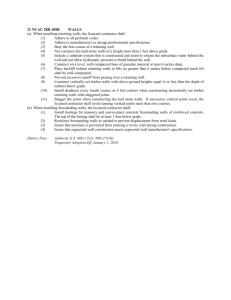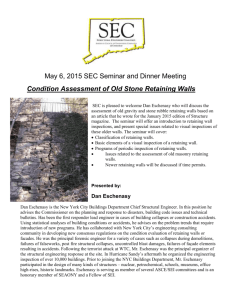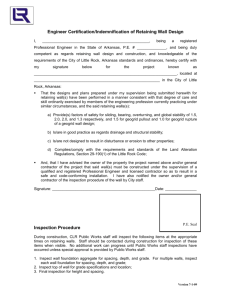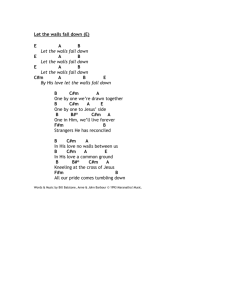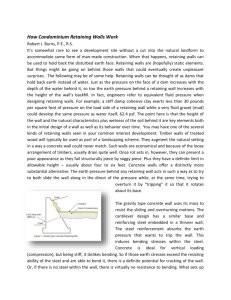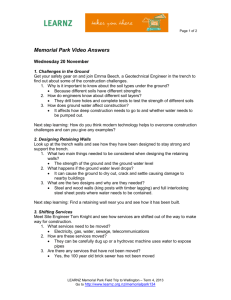COAST ASSESSMENT
advertisement
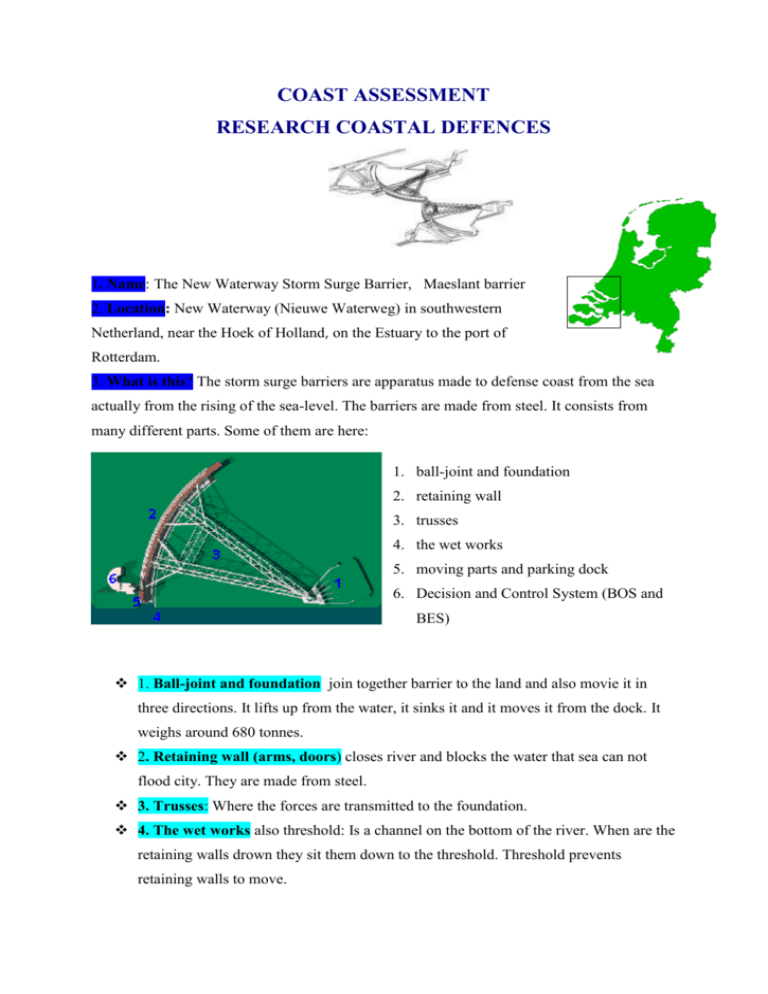
COAST ASSESSMENT RESEARCH COASTAL DEFENCES 1. Name: The New Waterway Storm Surge Barrier, Maeslant barrier 2. Location: New Waterway (Nieuwe Waterweg) in southwestern Netherland, near the Hoek of Holland, on the Estuary to the port of Rotterdam. 3. What is this? The storm surge barriers are apparatus made to defense coast from the sea actually from the rising of the sea-level. The barriers are made from steel. It consists from many different parts. Some of them are here: 1. ball-joint and foundation 2. retaining wall 3. trusses 4. the wet works 5. moving parts and parking dock 6. Decision and Control System (BOS and BES) 1. Ball-joint and foundation join together barrier to the land and also movie it in three directions. It lifts up from the water, it sinks it and it moves it from the dock. It weighs around 680 tonnes. 2. Retaining wall (arms, doors) closes river and blocks the water that sea can not flood city. They are made from steel. 3. Trusses: Where the forces are transmitted to the foundation. 4. The wet works also threshold: Is a channel on the bottom of the river. When are the retaining walls drown they sit them down to the threshold. Threshold prevents retaining walls to move. 5. Moving and parking dock: Special channels where the water is pumped. When there are no floods in the parking dock are there retaining walls and the docks are dry. But when there are floods the docks fill up with water and than the trains (locomobiles) push the walls on the middle of the river. This equipment is operated from control buildings on the north and south sides. Decision and Control System (BOS and BES) this is a special computer commander. In the storm surges sends commandos. Control system tells barriers to close the river. . Building up new barrier Decision and Control System 4. Why it was built? As we now Netherland is low lying area. In Netherland had a lot of problems with flooding by the sea in 1953 when there was a big flood. 1853 people were drowned and the Dutch government started with the preventing project named Delta Plan, which would prevent such disasters as last flood. The Delta Plan was completed but safety was only Zee-land. Government suggested to the southwestern people removal but people protested and suddenly they built up new storm surge barriers. In 1991 they started and the storm surge barrier was opened on a Saturday of 10th May 1997. 5. How it works? The retaining walls (barriers doors) are kept in the dock 260m long. When the sea-level reach more than 3.2 high the retaining walls are activated. Actually the Comment and Support system tells to the control system to shut the barriers. The barriers start to float on the water. The barriers close the waterway almost completely. Into the water they are driven by the small train and that process takes around half an hour. When the retaining walls are located in the middle of the waterway they open the valves and the water gets into the retaining walls. Because water is heavy it sinks the retaining walls for 17m.It touches the bottom of the river. On the bottom of the river there are thresholds and there is a lot of silt. The pressures of the retaining walls are so strong that they push the silt and the retaining walls sits exactly into the threshold. They are staying there so long till the sea-level doesn’t fall. After sea-level falls down the water from the retaining walls is pumped out of the retaining walls and they can float again. When they are floating the locomobiles (trains) drag retaining walls back to the dock. Suddenly they pump out also the water from the docks and retaining walls are staying in the dry dock. When the walls have to keep the water from the river estuary there is a big force, around 350 mega Newton. Because of those forces are there trusses. They pass forces to the foundation. Also the shapes of trusses reduce forces. 7. How much does it cost? The whole project, including the dike reinforcements cost 635 million Euros. The alternative plan predicted 150 million Euros more. If they would reinforced all the dikes it would take around 10 years but in this case it took 6 years. The money came from the Dutch government. 8. Effects on the surrounding area: During: During the building up the barriers they destroyed a lot of plants on the bottom of the sea. A lot of alga, animals from the bottom of the sea, a lot of fish died because the water was soiled. Saltwater fish died and birds moved away. But other species replaced them. Also the river estuary was closed for awhile and people couldn’t go out with the ships. After: After the barriers were built there was no covering of land by salty water. So the salty water hasn’t destroyed fertility of the land. Water hasn’t stayed in the closed estuaries for a long time so fish had more fresh and full with oxygen water. So this were good effect. The barriers have also attracted a lot of tourists. Only the appearance has changed and some animals are gone. Suddenly also people feel more comfortable and more safety. 9. Other relevant information: You can also visit storm surge barrier. They have special models which show how the barriers work. It is proved that since there are barriers the risk of floods it is reduces by about a quarter. Water is fresher. If we compare barriers with Eiffel tower we can find out that barriers are four times heavier than Eiffel tower even they are the same height. If you want to swim over the parking dock you have to swim around 4 times as long as is the Olympic length260m.
